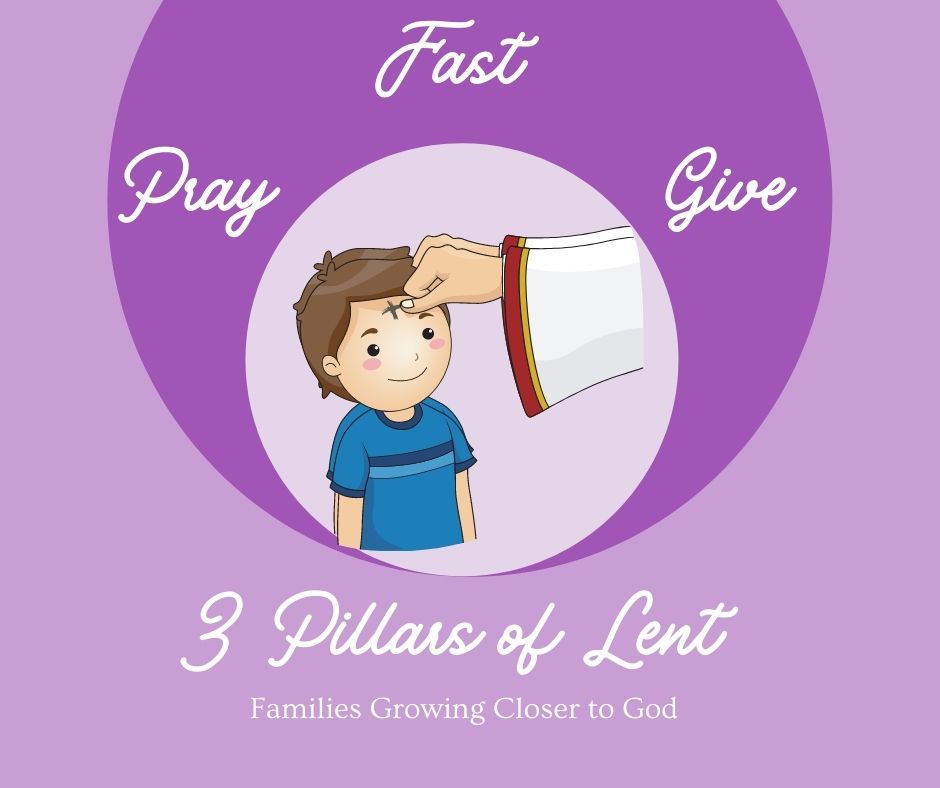A note from Kim: This is an updated version of my 3 pillars article from 2022. I write this article nearly every year, and I love it. I find myself looking forward to turning inward, heavenward with my family as Lent 2023 approaches!
******************
It’s hard to believe, but Lent begins in this Wednesday, February 22!
Lent is a time to prepare our hearts and minds for Easter. As a way to focus our preparation, the Church recommends “the 3 pillars of Lent”: prayer, fasting, and almsgiving.
While we (hopefully? sometimes? more or less?) practice these pillars all year round, we intensify our practice during Lent as we pause and reflect on our relationship with God and where we are in our spiritual journey.
Here are some ideas for practicing the 3 pillars with your children. If your family is new to these Lenten practices, just pick one simple practice in each of the three pillars.
1. Prayer
Setting aside more time for family prayer during Lent draws us closer to God and one another. Through family prayer, we begin to recognize ourselves as a family rooted in Christ, a family on a mission.
Make a plan. I admit that when you have kids, it’s easier to plan to pray than to follow through on it! Still, in my home at least, the plan makes family prayer more likely to happen, and we’re more likely to make it a habit.
In religious communities, members gather regularly throughout the day to pray together, and we can create similar rituals in our homes. Decide when you will have family prayer and post the schedule. Depending on your family’s daily routine and work commitments, you might pray in the morning before you all go your own ways, then again at dinner, and/or perhaps before bed. You can adjust your prayer schedule as needed.
Choose prayers. I find it helpful to use a dedicated devotional with my family during Lent; I tend to try something new every year. One year, I purchased a copy of Shorter Christian Prayer for each of my children, and I taught them how to pray the Liturgy of the Hours. Last year, we’re using Walking in the Footsteps of the Lord by the sisters at Openlight Media. This year, we’re using The Ascension Lenten Companion, which has daily reflections and prayers along with a journaling feature. We used Ascension’s Advent resource last year, and we all liked it. They offer weekly companion videos to accompany the book. Any of these suggestions work great with kids 10 and older.
If your kids are small, you might check out Sarah Reinhard’s family Lenten devotional. I’m also intrigued by The Word Became Flesh by Faye Maynard, which has daily reflections along with instructions for making a Lenten ornament wreath similar to an Advent Jesse tree.
Lectio Divina. Lectio Divina is a beautiful ancient form of prayer in which we meditate on a passage of scripture. I wrote a Lenten lectio divina guide specifically for families. It’s free to my subscribers, so check it out. I provided a “script” for you to lead your children through the stages of lectio, discussion questions, and art to contemplate. I think my guide works best for families with kids aged 5 and older, but you can still use it if some of your kids are little. I would shorten the meditations and use a children’s Bible for the scripture readings.
Stations of the Cross. Although I change up our Lenten devotions nearly every year, one thing remains the same: our Friday Stations of the Cross. Every Friday afternoon at 3:00 during Lent, we pray the Stations of the Cross as a family.
There are many guides available for praying the Stations with children. I adore this beautiful free booklet from Feast and Feria. They also offer ideas for creating a hands-on Stations of the Cross box. You place little objects in a box that your child can hold while your family prays the stations. My children have all commented on how much they like Mary’s Way of the Cross. The reflections are beautiful, and each booklet is only $2 so I was able to purchase a copy for everybody in the family.
If you have young kids, check out this Montessori-inspired stations of the cross lapbook from Lacy at Catholic Icing. I recently came across this gorgeous vintage-inspired black and white flipbook-style stations set; this would be great as a visual aid during your family stations prayers, but you could also use it as a coloring activity for small children while your family prays the stations.
If you’re looking for video-aids in leading your kids in the stations of the cross, here is a series by Catholic Kids Media (cartoon; younger kids) and CRS Rice Bowl (older kids and teens).
2. Fasting
During Lent, we “give things up” not to torture ourselves, but to free ourselves! By sacrificing food (including meat on Fridays for family members 14 and older) and other things we find pleasurable, we are eliminating any stumbling blocks between ourselves and God’s love. It’s a way of paying attention to unhealthy attachments. Usually the thing I most need to sacrifice for Lent is the thing I least want to sacrifice! Some children are too young to understand this spiritual battle, but we can still lead them in making their little sacrifices.
Sacrifice beans. Lacy over at Catholic Icing has a very do-able idea for using a box of beans to keep track of sacrifices and good deeds with your kids.
Family sacrifice. Every year my family chooses something to give up for Lent together in addition to our individual sacrifices. For the last several years, we gave up screens on Fridays. We receive many graces because of this sacrifice, and it makes our Friday Stations of the Cross all the more reverent.
Offer acts of faith. If your faith life is stale or stagnant, instead of giving up something tangible (like food), commit to praying every day instead. Our sacrifices should come from love, not a sense of guilt or obligation. I think it’s critical to teach this to our children.
Social media. I have another challenge for the modern family: don’t announce your sacrifices on social media. (This tip is most relevant for parents and teenagers.) While posting your sacrifices is a great way to offer a little insight into the richness of our Catholic Faith during Lent, it can also become an end in itself. You can start feeling like your sacrifice isn’t complete unless you’ve posted about it on social media. By making your sacrifices privately and without recognition, you are practicing many virtues: generosity, self-control, love, and humility. Oh, yes, and you can give up social media for Lent!
3. Almsgiving
As a sign of gratitude for all God has given us, and as an act of love to those in need, Christians give generously to the poor and needy, especially during Lent.
Donate toys and clothing. We can guide our children in choosing some of their toys and games to donate to charity, in addition to clothing they no longer wear. They can help us pack up these items and deliver them to charity shops. It’s easier to do it without our children’s help, but then they would miss the lesson in letting go of objects that can bless others.
Money jar. Many families keep a jar (or something similar) on the dinner table during Lent where they collect loose change, allowances, and money saved from abstaining from expensive foods and hobbies. Toward the end of Lent, we take this money and donate it to a charity that we choose together. If you need help finding a decent charity, Pope Francis launched the Missio app which allows you to donate to a charity with confidence that your money is going where it’s needed.
Alms of the heart. A lovely insight from Catherine Doherty: We can also offer alms of the heart in our families: little acts of kindness, words of encouragement, and hidden acts of service. These lessons are very powerful for children.
Subscribe to ICP Feed
Subscribers to Intentional Catholic Parenting (“ICP”) receive all blog posts and podcasts immediately after release.
ICP subscribers do not receive newsletter content (unless they subscribe to the newsletter separately).
Time commitment: Blog posts take 3-5 minutes to read; podcasts are about 20 minutes long.
Subscribe to Newsletter
“The Anchor and Maze” explores how parents can navigate the maze of parenting while remaining a child’s emotional anchor.
Newsletter subscribers receive links to recent posts, but possibly later than blog subscribers.
Time commitment: I keep the newsletter short. It takes about 1 minute to read.


